The Central Harts Range Fossicking Area lies due south of the Atitjere Community, and encompasses the abandoned mica mines of Mount Palmer.
The mine sites, besides providing the fossicker with mullock heaps to explore, are part of the Territory's heritage. The foundations of many stone-walled houses and bough structures (which once housed a community of up to one hundred men) remain, along with some mining equipment. Please respect them (See note on map 1).Scenically, the mountains have a grandeur and variation of colour as well as many strangely-shaped rock outcrops which will appeal to photographers. Mount Palmer, elevation 1136m, caps the mountains and provides views of the whole range.
Most of the slopes and ridges within the Fossicking Area are dominated by Mulga woodlands and Witchetty Bush shrublands. Creek lines are fringed in their upper regions by Inland Tea Tree and on their lower flanks by River Red Gums. In particular, Bean Trees with their winged leaves grow along the upper most parts of the Disputed Creek. Less undulating areas support open woodlands of Ironwood and Whitewood, often with an understory of Erect Kerosene Grass. Spinifex is fortunately not common in the area.
Minéralogie et géologie
http://www.nt.gov.au/dpifm/Minerals_Energy/index.cfm?header=Central%20Harts%20Range
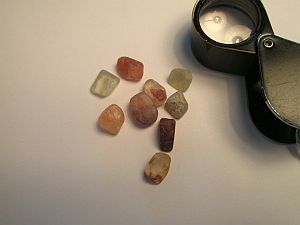
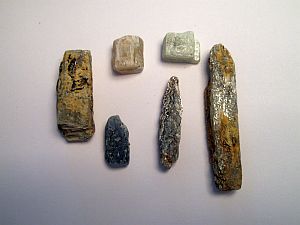
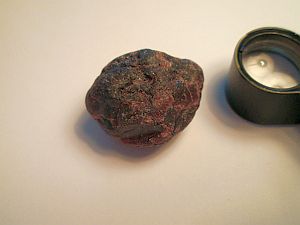
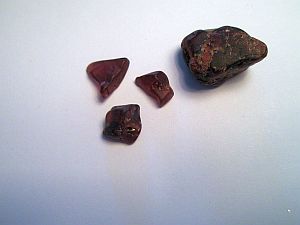
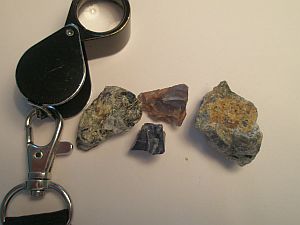
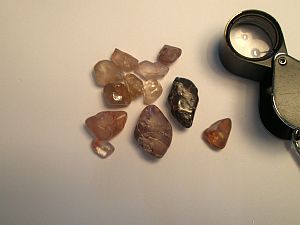
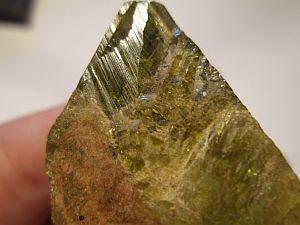
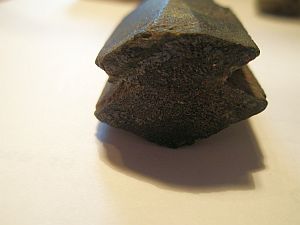
Discoveries:
|
Biotite |
| Blue Quartz | |
| Muscovite | |
| Perthite | |
| Graphic Pegmatite |
There are four adits on the hill face above the creek. The dump below the lowest adit, closest to the creek bed, yields abundant specimens of very coarsely-fractured, clear smoky quartz, colourless quartz and rose quartz. At the adits higher on the hill, a bluish-grey quartz can be found, some of which exhibits dendrite patterns of pyrolusite, a manganese oxide. Good specimens of feldspar can be found in large, cleaved prisms. Some of the feldspar (microcline) is perthitic. Specimens of graphic pegmatite can also be found. Muscovite is plentiful on the dumps, while biotite is present, but less common.
|
Magnetite |
| Biotite | |
| Muscovite | |
| Rose Quartz | |
| Garnet | |
|
|
|
Muscovite |
| Garnet | |
| Smoky Quartz |
Good samples of muscovite, some with red or black hematite stains in hexagonal patterns, can be found in mullock dumps or heaps of cutting waste. In general the muscovite occurs in the pegmatite, and the biotite is found as smaller books in the host rock metamorphics.
Beware of the many old mine shafts, some of which are unstable and dangerous. Two are covered, many have collapsed.
Smoky quartz is reasonably common on the dumps, but garnets are sparse, although the country rock does contain some garnet and beryl. Good examples of perthitic feldspar (microcline) can be found, some of which is graphically intergrown with quartz. Tourmaline is present as schorl, but is scarce in the quartz and feldspar.
|
Muscovite |
| Biotite | |
| Beryl | |
| Tourmaline | |
| Garnet | |
| Rose Quartz | |
| Smoky Quartz |
Clear ruby-coloured muscovite and black biotite are plentiful on the dumps. Small flakes of olive green mica are also common. Good samples of rose quartz and smoky quartz have been found in the mullock heaps but the material is not plentiful. Clear, red garnets have been found in the bedrock.
Specimens of perthitic feldspar are not as common, nor of as good quality, as those nearby in the Spotted Tiger Mines. Tourmaline is common as small, thin, black prismatic crystals in quartz or feldspar. Beryl is difficult to find on the dumps.
Mica Mines in the Mount Palmer Environs
The following named mines are found in this area: Billy Hughes Mine, Oolgarinna Mine, Caruso Mine, Spotted Dog Mine and Disputed Mine.
Similar minerals can be found at most of the mine sites: Muscovite, Biotite, Tourmaline, Clear Quartz, Garnet, Smoky Quartz, Rose Quartz, rare Beryl, rare Amethyst, Graphic Pegmatite, Pink Feldspar, Blue Quartz, Yellow-green Mica.
Muscovite and biotite are common to localities in the Mount Palmer area. At the Spotted Dog Mine, the mica books show hermatite staining, which gives the specimens an attractive cross-ribbed or hexagonal pattern similar to the mica at the Spotted Tiger Mine.
Both ruby and white muscovite mica are found at the Caruso Mine where some specimens have inclusion of quartz. Quartz crystal is ubiquitous. At some localities both smoky and rose quartz exist while at others, such as the Spotted Dog Mine, attractive transparent quartz crystal is found.
Below the peak of Mount Palmer, on the steep western side, clear quartz, suitable for faceting or for use in doublets and triplets, can also be found. This area is an excellent source of feldspar crystals. These have formed in a pegmatite which contains large polygonal crystals of feldspar and sometimes large beryl crystals as well. Many of the pegmatites in the Mount Palmer area exhibit graphic textures and some, such as the one at Caruso Mine, contain limonite pseudomorphs after cubic pyrite crystals. These are commonly called "devil's dice".
Beryl may also be found at the Caruso and Disputed Mines.
One of the most attractive and commonly found minerals in the area is tourmaline. It is found as radiating clusters of needle-like crystals. At the Caruso Mine some quartz contains tourmaline inclusions up to 12cm long and 3cm thick. An unusual white mineral has formed as radiating crystals on joint faces in the dark metamorphosed igneous rock around Billy Hughes Mine. The mineral is probably a zeolite.
|
Muscovite |
| Biotite | |
| Garnet | |
| Rutile | |
| Cassiterite |
Ruby-coloured muscovite, and, to a lesser degree, biotite, are common on the dumps. This mine was regarded in 1955 to have produced some of the best quality mica in the Harts Range. Red garnets can be found in the quartz and feldspar, and some garnets can be found loose on the slopes around the mine. Large garnets up to 2cm occur in some of the biotite schist material from the upper mines, but these are not as well formed as the smaller garnets, nor as transparent.
The quartz-feldspar intergrowth has a graphic texture and is stained with pyrolusite dendrites. Cassiterite has been reported to occur in the wall rocks of this mine, and rutile has been observed in some of the pegmatites surrounding the mine: However, such minerals are rare.
The shafts are dangerous and have been closed, but the mullock heaps are extensive.
Central Mine - Muscovite, Rose Quartz, Smoky Quartz, Clear Quartz, Graphic Pegmatite.
The mine is situated in amphibolite rock from which some good specimens of hornblende can be obtained. Rose quartz, smoky quartz and clear quartz, some of which may be suitable for cutting, can be found on the slopes below the mine. Muscovite and samples of graphic pegmatite are plentiful.
Access: Benstead, Painted Canyon and Butcher Bird Mines
From a cattle grid 63km east of The Gemtree Caravan Park along the Plenty Highway (or 11km west of the Atitjere Community turnoff) travel south-west along a fence for 1.7km, then veer right, following the track for a total of 6km, then turn left on to an old track. Follow this track east for a further 1.5km; the track then forks right to Painted Canyon Mine. Follow the older (left-hand) track across the creek for 0.7km. Benstead Mine is located approximately 200m to the south of the track.
From the fork mentioned above, follow the right-hand track south-west for 1.5km; from this point follow the stream bed upstream for a further 1km to painted Canyon Mine.
From Painted Canyon Mine, travel a further 1km upstream, then on foot to Butcher Bird Mine (approximately 45 minutes' walk). Commence by walking south through a small gorge, turn east (left) then south into a more open area. Follow the creek south around its eastern meander, then turn into the major tributary which enters the creek from the south-east. This tributary then turns south-west (right) then east (left) into a flat, open area. The tributary passes Butcher Bird Mine at the eastern end of the flat, open area.
Mount Palmer Area and Rex Mine
Fossickers wishing to access the Mount Palmer area are advised that the track to the area passes through Spotted Tiger Bore (Pwetyalaneme) Aboriginal Land. The traditional owners do not require fossickers to apply for permits to enter Aboriginal Land. They do however request that fossickers observe the normal courtesies and check with the Atitjere Council office (next to the Community store) before proceeding to the area.
Conditions of access to the Mount Palmer area may be subject to change, and fossickers are therefore advised to check with the Community Office before proceeding.
From the Community, travel west along the Plenty Highway, then along the track to the Harts Range Racecourse. Veer right at 5.4km (near the racecourse) and follow the track to Spotted Tiger Bore. From there follow the signs to the Mount Palmer track. Again as a matter of courtesy, if the manager of the Spotted Tiger Campground is on site, let him/her know of your presence and intended activities.
From the campground, follow the track for 4km to a point where the track forks; the left fork leads 1km to the Rex Mine, while the right fork leads 1.5km to the Disputed Camp, which is the limit of vehicle access. From the Disputed Camp, walk approximately 200m up the south (left) bank of the nearby creek until pointers indicating the walking track to the Spotted Dog and Disputed Mines are located. From the Disputed Mine, it is possible to climb to Mount Palmer and smaller mines on its slopes. The very enthusiastic walker may continue by following the old Burma Road (now closed to vehicular traffic because of its dangerous condition) and, from it, visit the Billy Hughes and Oolgarinna Mines on the western slopes of the main range.
Driving Tips:Tracks are recommended for four-wheel drive vehicles only.
The old Burma track has been closed to traffic by the Police.Camping:"Bush Camping" is allowed however, please note that there are no facilities on site. The Spotted Tiger Campground situated at the entrance to the Mount Palmer area offers camping facilities. Fuel, groceries and general supplies are available at the nearby Atitjere Community store, along with a unique opportunity to view and purchase Aboriginal artifacts and paintings.
Campers on the Fossicking area must provide their own water. However, bore water is available at the Atitjere Community store.
Campers must take their rubbish with them when they leave.
PLEASE REMEMBER THAT THE FOSSICKING AREA LIES WITHIN MT RIDDOCK STATION AND CARE SHOULD BE TAKEN NOT TO INTERFERE WITH THE MOVEMENT OF CATTLE OR OTHER STATION ACTIVITIES.
GEOLOGY OF CENTRAL HARTS RANGE
The rocks of the Mount Palmer area of the Harts Range region are all part of the Harts Range Group (Cover Sequence) which are lower to middle Proterozoic in age. They have a complicated structural and metamorphic history typical of the whole Arunta Block of which they form a small part. The Harts Range Group have been described as forming a cover-basement relationship with the Irindina Gneiss forming the lowest part of the cover sequence. This is based on the observation that the cover units have not undergone the granulite facies metamorphism of the basement, but have been later metamorphosed to upper amphibolite facies, which also imprints on the basement as a retrograde metamorphic event.
The Harts Range over rocks are thought to be a volcano-sedimentary suite deposited in a possible continental rift or failed rift of the basement after 1780 million years ago. Basic and ultrabasic volcanism and/or plutonism followed the initial rifting and sandstones, mudstones and some limestones were also deposited in the resulting basin. These then underwent heating and deformation resulting from compression of the crust caused by the continuation of the Strangways event, ending at around 1730 million years ago. This later amphibolite facies metamorphism (involving folding and faulting) virtually destroyed the original characteristics of the rock except for the gross lithological variations which are now recognisable as compositional layering. Other later orogenic events recorded elsewhere in the Arunta Block played a minor role in this area. The numerous crosscutting pegmatites are much younger and represent the conclusion of a tectonothermal phenomenon that occurred about 520 million years ago (Cambrian Period). The interaction of the pegmatites and the surrounding meta-sediments and meta-igneous rocks provides the right conditions for the formation of large, high-quality mineral specimens. The Alice Springs Orogeny (Devonian to Carboniferous, 300-400 million years ago) is responsible for the latest major uplift which has brought these rocks sufficiently close to the surface for their ultimate exposure through erosion.
Garnets
Garnets are formed by metamorphism of rocks with a high aluminium content, which is usually clay-rich sediments. They are also formed in zones of intense deformation where they coincide with biotite mica which weathers readily to expose the more resistant garnet. Different varieties may form depending on the composition of the original rock such as andradite (Ca, Fe variety) from calcareous sediments, almandine (Fe, Al) from clay-rich sediments and pyrope (Mg, Al) from magnesium-rich basic and ultrabasic igneous rocks.
Pegmatite
Muscovite (white mica) is common in the pegmatites which are formed by the very last stages of crystallisation of a granitic melt (not exposed in the Harts Range region). The growth of large crystals is assisted by the slow crystallisation, and the presence of volatile components of the melt (H20, C02, F). This results in the formation of large, low temperature minerals (quartz, microcline feldspar, muscovite and some biotite) and because of the efficient scavenging effects of the volatile elements, minerals containing less common elements form, such as beryl, tourmaline, apatite and occasional cassiterite and magnetite.
Fossicking in the Harts Ranges,
Fossicking en NT - licence en ligne
Gemtree Caravan Park
Hessonite à Harts Range
Quartz scepter crystals from the Entia Valley, Harts Range, Central Australia
Mineralogical Record, Nov/Dec 2002 by McColl, Don
U-Pb ages from the Harts range, central Australia : evidence for early Ordovician extension and constraints on Carboniferous metamorphism
URANIUM/COPPER/GOLD PROSPECTS AS NEWERA CONSOLIDATES GROUND
POSITION IN HARTS RANGE – NORTHERN TERRITORY
Carte des exploitations minières
"Mud Tank" Zircon Field, Harts Range, Northwest Territory, Australia
Harts Range
Kornerupine and Sapphirine Crystals from the Harts Range, Central Australia
Post-1550 Ma tectonism in the
North Australian Craton
Find out more about Prospecting...